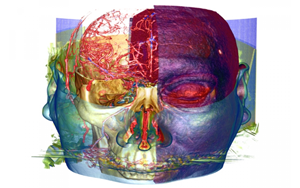Written by Julie Kiefer
 The collection of images appears to be a study in shape, color, and design. Zig-zagging lines that meld into smoke-like ribbons; an explosion of colors that seemingly blasts beyond the frame; a brain washed in pastels (see Image Gallery below). What at first glance looks like art is actually much more. Each piece is a window into scientific discovery.
The collection of images appears to be a study in shape, color, and design. Zig-zagging lines that meld into smoke-like ribbons; an explosion of colors that seemingly blasts beyond the frame; a brain washed in pastels (see Image Gallery below). What at first glance looks like art is actually much more. Each piece is a window into scientific discovery. The collection comes from the Scientific Computing and Imaging (SCI) Institute at the University of Utah, a group of computer scientists that specializes in making visually oriented simulations and interactive software. They collaborate with researchers in fields ranging from astrophysics to the health sciences, to find new ways to gather and make sense of their data.
"Half of our brain is used for image processing, and visual processing is the fastest of our senses," says Chris Johnson, director of the SCI Institute. "Visualization is a good way for us to interface with all that data."
Though visualizing data may sound highly technical, it has real world applications. Johnson shows an image of a brain with a tumor, reconstructed from datasets that come from CT scans. One side of the tumor has a clear boundary that delineates where a surgeon should cut to remove it. The other side is fuzzy; it’s not clear where that side of the tumor ends.
Johnson then overlays a graphic, generated from algorithms used to find the edges of the tumor. On the fuzzy side, lines demarcate the closest and furthest points where that boundary might be.
"If this is your brain, where do you tell the surgeon to cut? Be aggressive? Maybe keep a little more brain. How about just take the mean," he says. The simple act of looking at a single picture arms physicians and patients with knowledge to make an informed decision.
That is the purpose of scientific visualizations, to clearly communicate data so that others may understand and better use the information behind it.
With a growing appreciation for the impact that thoughtfully made visuals can have, more researchers are integrating art into their science.
Nathan Galli, a classically trained artist with no formal science education, was hired by the SCI Institute thirteen years ago. He says he was the first artist to become part of a research team at the university. "When I was hired it was not very well received … Now everybody has one," he says. Galli lends an artistic eye to scientists’ presentations and visualizations.
Galli’s artistic skill has also enabled scientists to glean more from research. One of his projects was to add design elements to the interactive software, EpiCanvas, made for tracking disease outbreaks. His recommendations to simplify the interface, and add maps, graphics and other features, made EpiCanvas not only better to look at, but also easier for epidemiologists to use and understand. Published last year, the software has already won awards and piqued the interest of the Center for Disease Control.
Janet Iwasa thinks that giving researchers themselves the ability to make art will help them become better scientists. A new member of the research faculty in the department of biochemistry at the University of Utah, she is a scientist who uses artistic techniques. Her lively animated movies of biological processes depict scenes such as colorful proteins doing their jobs within cells. She is leading a team in creating intuitive animation software called Molecular Flipbook that promises to turn scientists into animators after a brief tutorial.
"Animations are a means of being able to communicate hypotheses as well as explore them in a way that I think scientists need to do." She says the process of making animations can help scientists crystallize their hypotheses.
The idea stems from her observations that being forced to visualize in detail the various biological steps she is animating, reveals gaps in knowledge. "At that point there’s a lot of insight or understanding into what people know and don’t know," she says. "Often that itself is enough to get new ideas rolling."
The art world has started to take notice of the stunning visuals that come out of science. The SCI Institute put their images on exhibit, including at a show at the Kimball Art Center in Park City. Iwasa’s movies have been on display at The Leonardo art and science museum in Salt Lake City, and other venues.
"It's a friendlier way of making people think about proteins in a molecular scale, in an environment that's not as intimidating as a classroom," says Iwasa.
Artistry opens the door for anyone to appreciate the science behind the pictures.
